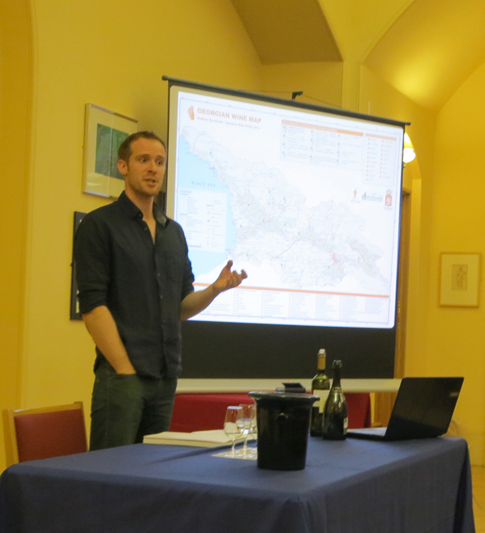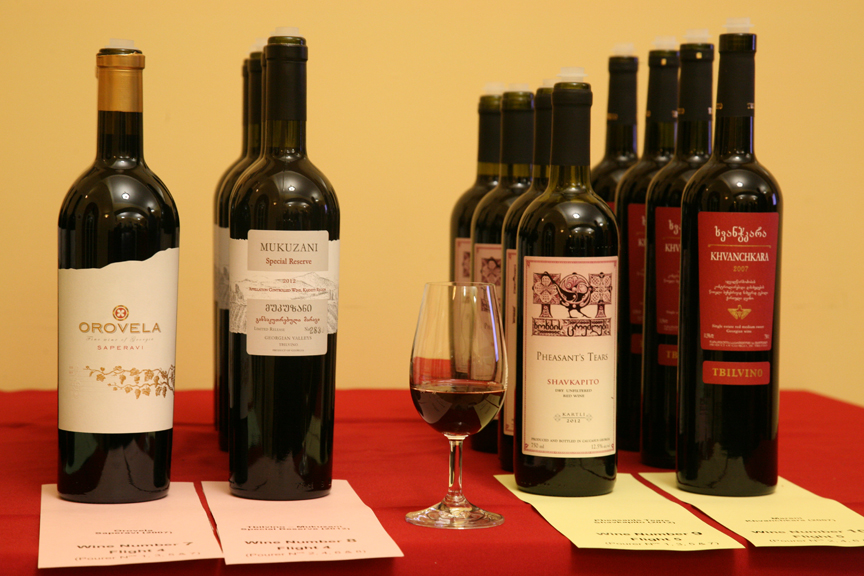Chris Bowling is known to many as the founder of this year's successful Oxford Wine Fair - but he's also founder of the Georgian Wine Society (www.georgianwinesociety.co.uk), dedicated to searching out the best of Georgian wine and making it available to drinkers in the UK. The introduction promised tales of personal derring-do but what Chris' fascinating presentation made clear was that behind the marketing line of 'Seven Thousand Years of Continuous Vintages' and the world's oldest (perhaps the world's original) wine culture lies a somewhat hazardous life for Georgian wine-growers and wine-lovers.

In Georgia a good harvest is a sign of good times - and the many invaders and occupiers of this country that lies on a geo-political fault line have targeted the vines. The Russians - despite Joseph Stalin's love of the semi-sweet Khvanchkara - designated Georgia as the mass producer for Russia and ripped out almost all the quality grapes in favour of the prolific and over-cropped Rkatsiteli. Only a few tens or hundreds of hectares survive of some of the 540 indigenous grapes. Scarcity of some of the finest of these grapes means high demand and we can be grateful to Chris for securing stocks of some of these rarities and making them available to us. The supras - the Georgian feasts where plates are stacked three deep and the wine budget for men is 3 litres - are clearly another hazard to face. And then there are the quevris, the buried clay pots in which the traditional wine is made. To clean the bigger quevris (an essential annual task if you wish to avoid vegetal flavours in the wine) demands sending a boy or small man down into the pot with a high risk of asphyxiation.
But the quevris - on the verge of extinction ten years ago but now thriving with UNESCO support - make fascinating wine and good judges such as Andrew Jefford and Oz Clarke reckon that Georgian wines may well be some of the most interesting and influential of the next ten years.
We began the tasting with the bottle-fermented Bagrationi 1882 sparkling wine. The first serious wine-making Bagrationi, direct descendant of a Tolstoyan hero from War and Peace, introduced sparkling wine to Georgia and won prizes for his wine in International Exhibitions at the turn of the nineteenth century. We tasted the Reserve Brut of 2008 - a highly perfumed, rich golden wine with a fine mousse and aromas of peaches, apricots and melons and a pleasingly bitter / yeasty note on the finish.
Wine no. 2 was the Tbilivino Winery's Tsinandali 2011 from the Georgian Valleys in the east of the country. This well-priced (£9.99) wine has won both IWC and Decanter awards. It's made from Rkatsiteli, the Soviet volume workhorse but ironically the misguided target of Mikhail Gorbachov's own vine-pulling scheme when he became alarmed about the extent of Russia's alcohol problem. Well-made and with restricted yields, Rkatsiteli makes fine wines that are both honeyed on the nose and savoury in the mouth. Even unoaked, they have the body to complement the renowned middle-Eastern influenced Georgian cuisine that all visitors enthuse over (even if they can't manage the day-long feasts that Chris mentioned).
Wine no. 3 was the first of two white quevri wines. Uniquely, quevri wines are made entirely in the clay pots. Sometimes these are lined with beeswax for easier cleaning (and perhaps this contributes to their often honeyed aromas) whilst the best are made from silver-rich clay which has an anti-bacterial effect. The harvested grapes are poured straight into the quevri - always with skins, sometimes with stems as well. According to natural wine specialist Isabelle Legeron, fully ripe stems are used to give complex wild-flower aromas (but beware the green notes from less ripe stems).
The first wine (a 'quevri-lite' in Chris's view) was 100% Rkatsiteli. Deep gold in colour this was slightly honeyed with a trace of volatile acidity and a dominant note (as the wine opened up) of candied orange peel. Then, in the mouth the wine was very dry with unexpected tannins and a depth of body that would beautifully complement the barbecued white meats and nut sauces that characterise the local food.
Wine no 4 was the Quevri Rkatsiteli from Alaverdi Monastery (www.since1011.com), where Friar Gerasim is the latest in a long line of monk wine-makers. This is by any standards a remarkable (white) wine. The colour is amber shading to red with just a narrow paler rim. A complex, powerful nose with tea leaves, plum and apple compote spiced with cloves, and as it stood in the glass increasingly perfumed and candied. Chewy tannins and again a savoury note to the fruit in the mouth but overall a sense of great power and complexity. As Chris said, this is not a wine that everybody falls for at first sip but it is a wine that will age, a wine that stands repeated re-tasting as it evolves in the glass. It's currently £21.99 through Chris's website (and please note that he is also offering all Oxford Wine Club members a 10% discount).
With wine no. 5 we switched to rosé. The Teliani Valley 2008 we tried was made from the Saperavi grape, probably Georgia's best claim to a true noble grape, and one which is expressed in a variety of wines. This was a light plum-coloured wine with amber notes, a colour achieved after only 8 hours on the skins thanks to the rare rosy tint of the juice. The nose expressed both black and red fruits and in the mouth it was dry, fresh, well-balanced and a rich mouthfeel with notes of homemade raspberry jam. Bright, very drinkable and a long finish, this was the favourite wine of many at the tasting and it is only £9.99 from Chris.
 The next four wines were dry reds - two from the Saperavi grape and one each from the rare Mukuzani and Shavkapito (only 10 hectares left in Georgia) grapes.
The next four wines were dry reds - two from the Saperavi grape and one each from the rare Mukuzani and Shavkapito (only 10 hectares left in Georgia) grapes.
Wine no 6 was the 2013 Saperavi from Tbilvino. Almost ink black in colour with only a narrow purple rim this wine had a claret-type nose of black fruit with blackcurrants, elderberries and a touch of violet. Dry, tannic, yet with a sweet mouthfeel, this wine is till very youthful but with age it should show well and work wonderfully with red meat.
Wine 7 was a much older Saperavi 2007 from the Orovela winery. Tagged by some writers as a 'Super Georgian' this is a wine with power and the expressive richness of many of the garagiste wines. On the nose it showed plums, ripe blackcurrant, blackberries and mulberries with a touch of 'forest floor' as it developed in the glass. The oak treatment (50% French and 50% American) gives it richness and restraint and at £18.90 it's a bargain compared to other 'super' wines, especially since it clearly has the capacity to age further..
Wine no 8 was Tbilvino's Special Reserve Mukuzani. This again had a rich and complex black fruit nose. In this case, the 12 months of oak treatment had added a minty note (reminiscent of some high-class Australian reds) to the blackcurrant, mulberry and licorice aromas. Scarcity and high demand mean a price to match - £29.99.
Wine no. 9 was the last of the dry reds. The Pheasant's Tears name alludes to the Georgian proverb that when pheasants meet particularly good grapes (or was it wines?) then they start to cry... The winemaker here has what Chris described as organic and biodynamic tendencies and uses 100-200 year old quevris to make this unfiltered wine which has a deep purple colour and a smoky bouquet of black truffles and blackcurrant leaves. This wine used to be reserved for the Georgian Royal Family but is available from Chris at £16.99.
The last wine of the evening was Marani's Khvanchkara 2007 at £13.99. This is a semi-sweet red wine made with a blend of indigenous grapes. It's in very high demand in Russia and is likely to be withdrawn from the UK market soon so well worth getting a bottle or two to try. The colour is a paler red than the dry wines above and with age is now showing hints of amber in the rim. Again there is the apple-compote-with-cloves note in the nose plus cherries and mulberries and a pleasing touch of pepper in the mouth and finish. Though semi-sweet this is also a wine that well-chilled would work with savoury food, particularly grilled meats with rich fruit or nut sauces and strong spicing.
Thanking our speaker, Colin Redman reckoned Chris had recreated a recent week-long trip that he and Sandie had taken to Georgia and had not only evoked the beauty and hospitality of the region and its inhabitants but had brought for us a remarkably fine selection of its wines. To repeat, Chris has offered members a 10% discount on orders through his website and it's an offer that's well worth taking up.
GH: 21/10/14